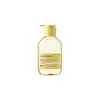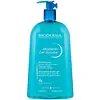What's inside
What's inside
 Key Ingredients
Key Ingredients

 Benefits
Benefits

 Concerns
Concerns

 Ingredients Side-by-side
Ingredients Side-by-side

Water
Skin ConditioningSodium Laureth Sulfate
CleansingCocamidopropyl Betaine
CleansingAmmonium Lauryl Sulfate
CleansingParfum
MaskingSodium Chloride
MaskingSorbitol
HumectantSodium Benzoate
MaskingLimonene
PerfumingCaprylyl Glycol
EmollientPhenoxyethanol
PreservativeLinalool
PerfumingCitric Acid
BufferingPolyquaternium-10
Disodium EDTA
Ethylhexylglycerin
Skin ConditioningHexyl Cinnamal
PerfumingButylene Glycol
HumectantCitrus Limon Peel Oil
MaskingShale Extract
EmollientBellis Perennis Flower Extract
Skin ConditioningPulmonaria Officinalis Extract
AstringentCitrus Limon Peel Extract
EmollientTocopherol
AntioxidantWater, Sodium Laureth Sulfate, Cocamidopropyl Betaine, Ammonium Lauryl Sulfate, Parfum, Sodium Chloride, Sorbitol, Sodium Benzoate, Limonene, Caprylyl Glycol, Phenoxyethanol, Linalool, Citric Acid, Polyquaternium-10, Disodium EDTA, Ethylhexylglycerin, Hexyl Cinnamal, Butylene Glycol, Citrus Limon Peel Oil, Shale Extract, Bellis Perennis Flower Extract, Pulmonaria Officinalis Extract, Citrus Limon Peel Extract, Tocopherol
Water
Skin ConditioningSodium Laureth Sulfate
CleansingCoco-Betaine
CleansingSodium Lauroyl Sarcosinate
CleansingGlycerin
HumectantMethylpropanediol
SolventCoco-Glucoside
CleansingGlyceryl Oleate
EmollientDisodium EDTA
Citric Acid
BufferingCapryloyl Glycine
CleansingCopper Sulfate
Skin ConditioningXylitylglucoside
HumectantAnhydroxylitol
HumectantXylitol
HumectantNiacinamide
SmoothingGlucose
HumectantFructooligosaccharides
HumectantMannitol
HumectantTocopherol
AntioxidantHydrogenated Palm Glycerides Citrate
EmollientLecithin
EmollientRhamnose
HumectantAscorbyl Palmitate
AntioxidantParfum
MaskingWater, Sodium Laureth Sulfate, Coco-Betaine, Sodium Lauroyl Sarcosinate, Glycerin, Methylpropanediol, Coco-Glucoside, Glyceryl Oleate, Disodium EDTA, Citric Acid, Capryloyl Glycine, Copper Sulfate, Xylitylglucoside, Anhydroxylitol, Xylitol, Niacinamide, Glucose, Fructooligosaccharides, Mannitol, Tocopherol, Hydrogenated Palm Glycerides Citrate, Lecithin, Rhamnose, Ascorbyl Palmitate, Parfum
 Reviews
Reviews

Ingredients Explained
These ingredients are found in both products.
Ingredients higher up in an ingredient list are typically present in a larger amount.
Citric Acid is an alpha hydroxy acid (AHA) naturally found in citrus fruits like oranges, lemons, and limes.
Like other AHAs, citric acid can exfoliate skin by breaking down the bonds that hold dead skin cells together. This helps reveal smoother and brighter skin underneath.
However, this exfoliating effect only happens at high concentrations (20%) which can be hard to find in cosmetic products.
Due to this, citric acid is usually included in small amounts as a pH adjuster. This helps keep products slightly more acidic and compatible with skin's natural pH.
In skincare formulas, citric acid can:
While it can provide some skin benefits, research shows lactic acid and glycolic acid are generally more effective and less irritating exfoliants.
Most citric acid used in skincare today is made by fermenting sugars (usually from molasses). This synthetic version is identical to the natural citrus form but easier to stabilize and use in formulations.
Read more about some other popular AHA's here:
Learn more about Citric AcidDisodium EDTA plays a role in making products more stable by aiding other preservatives.
It is a chelating agent, meaning it neutralizes metal ions that may be found in a product.
Disodium EDTA is a salt of edetic acid and is found to be safe in cosmetic ingredients.
Learn more about Disodium EDTAParfum is a catch-all term for an ingredient or more that is used to give a scent to products.
Also called "fragrance", this ingredient can be a blend of hundreds of chemicals or plant oils. This means every product with "fragrance" or "parfum" in the ingredients list is a different mixture.
For instance, Habanolide is a proprietary trade name for a specific aroma chemical. When used as a fragrance ingredient in cosmetics, most aroma chemicals fall under the broad labeling category of “FRAGRANCE” or “PARFUM” according to EU and US regulations.
The term 'parfum' or 'fragrance' is not regulated in many countries. In many cases, it is up to the brand to define this term.
For instance, many brands choose to label themselves as "fragrance-free" because they are not using synthetic fragrances. However, their products may still contain ingredients such as essential oils that are considered a fragrance by INCI standards.
One example is Calendula flower extract. Calendula is an essential oil that still imparts a scent or 'fragrance'.
Depending on the blend, the ingredients in the mixture can cause allergies and sensitivities on the skin. Some ingredients that are known EU allergens include linalool and citronellol.
Parfum can also be used to mask or cover an unpleasant scent.
The bottom line is: not all fragrances/parfum/ingredients are created equally. If you are worried about fragrances, we recommend taking a closer look at an ingredient. And of course, we always recommend speaking with a professional.
Learn more about ParfumSodium Laureth Sulfate (SLES) is a foaming, cleansing, and emulsifying ingredient. It is created from palm kernel oil or coconut oil. SLES is not the same as sodium lauryl sulfate. It is much milder and less likely to irritate.
SLES helps create foam in personal products. It also prevents ingredients from separating, helping to elongate the shelf life.
Sodium Laureth Sulfate is a type of sulfate. It can be drying. We recommend speaking with a professional about using this ingredient if you have concerns.
Learn more about Sodium Laureth SulfateTocopherol (also known as Vitamin E) is a common antioxidant used to help protect the skin from free-radicals and strengthen the skin barrier. It's also fat soluble - this means our skin is great at absorbing it.
Vitamin E also helps keep your natural skin lipids healthy. Your lipid skin barrier naturally consists of lipids, ceramides, and fatty acids. Vitamin E offers extra protection for your skin’s lipid barrier, keeping your skin healthy and nourished.
Another benefit is a bit of UV protection. Vitamin E helps reduce the damage caused by UVB rays. (It should not replace your sunscreen). Combining it with Vitamin C can decrease sunburned cells and hyperpigmentation after UV exposure.
You might have noticed Vitamin E + C often paired together. This is because it is great at stabilizing Vitamin C. Using the two together helps increase the effectiveness of both ingredients.
There are often claims that Vitamin E can reduce/prevent scarring, but these claims haven't been confirmed by scientific research.
Learn more about TocopherolWater. It's the most common cosmetic ingredient of all. You'll usually see it at the top of ingredient lists, meaning that it makes up the largest part of the product.
So why is it so popular? Water most often acts as a solvent - this means that it helps dissolve other ingredients into the formulation.
You'll also recognize water as that liquid we all need to stay alive. If you see this, drink a glass of water. Stay hydrated!
Learn more about Water